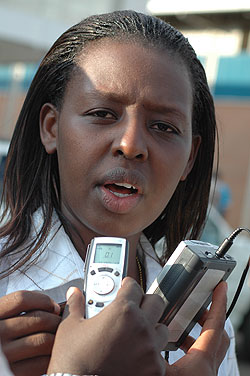By Festo Ngamije “Halting and reversing the spread of AIDS is not only a Goal in itself is a prerequisite for reaching almost all the others. How we fare in fighting AIDS will impact all our efforts to cut poverty and improve nutrition, reduce child mortality and improve maternal health, curb the spread of malaria and TB.


By Festo Ngamije
"Halting and reversing the spread of AIDS is not only a Goal in itself is a prerequisite for reaching almost all the others. How we fare in fighting AIDS will impact all our efforts to cut poverty and improve nutrition, reduce child mortality and improve maternal health, curb the spread of malaria and TB.
Conversely, progress towards the other Goals is critical to progress on AIDS from education to the empowerment of women and girls.” the United Nations Secretary-General Mr. Ban Ki-moon.
Over the past few years, Rwanda has made substantial progress in its efforts to meet MDG6, which calls for stopping the spread of HIV and reversing the HIV epidemic by 2015. For example, the expansion of services for the prevention of mother-to-child transmission and access to antiretroviral treatment and the introduction of new prevention technologies namely male circumcision.
However, stopping new HIV infections is the biggest challenge facing the attainment of MDG 6 so there is an urgent need to intensify proven combination prevention programs.
From 20th - 22nd September, a summit will be held in New York to focus on the Millennium Development Goals. The summit provides a unique opportunity to evaluate how countries- and the international community at large- are responding to AIDS and other health and developing issues.
Turning on Rwanda, the multisectoral AIDS response is based on the principles of the "Three Ones” (one national coordinating body, one strategic national plan and one sole monitoring and evaluation framework) and have registered several successes. Some 76,700 individuals were receiving ART in 2009 (representing more than 70 percent of those in need).
About 68 percent HIV positive pregnant women received antiretroviral to reduce the risk of mother-to child transmission in 2009. Availability of condoms has substantially increased in the past years and dialogue is getting more open about their use.
However, a prevention revolution is required to meet MDG6. For instance, the offer of male circumcision services need scaling up. A complete package of prevention services should be offered to all, including and in particular to youth, couples where partners have different HIV status and population groups with high risk of exposure to the HIV virus such as sex workers and their clients.
Research and analysis from various sources point to a number of broader socio-cultural and environmental factors that influence vulnerability to HIV infection. These include: marginalisation of at risk population; gender inequality and violence against women and girls, practices associated with multiple concurrent partnerships and cross-generational sex; conservative attitudes in discussing sexual matters; attitudes of service providers and limited access to comprehensive prevention packages in some cases.
Is breaking the trajectory of the AIDS Epidemic essential in achieving MDGs in Rwanda?
The impact of AIDS can be felt across several of the MDGs. So stopping new infections in the country and reducing AIDS- related deaths is having a direct impact across the Millennium Development Goals. For instance prevention of mother to child transmission (PMTCT) stops mothers from dying and babies from becoming infected.
But it also promotes linkages for better health during and post- pregnancy as well as for broader maternal and child health services (MDG 4 and 5). UNAIDS has called for the virtual elimination of mother to child transmission of HIV by 2015.
As well, antiretroviral treatment keeps people healthy and fit to work and reduces the number of children becoming orphans (MDG 1). Support to orphans and other vulnerable children allow them to stay in school (MDG 2).
HIV is a smart and proven investment. At this point, reductions in funding will hurt the AIDS response and other development goals.
Are we on track to meet the MDGs?
The advances made in the AIDS response demonstrates that meeting the MDGs can be achieved-when the right policies and programs are backed by sufficient resources and political commitments.
Globally, progress on the MDGs has been uneven. While some countries like Rwanda have made great strides, others are falling short. In many regions, gains in the HIV response have been eroded by the global financial crisis and on-going recession.
The upcoming MDG summit at the United Nations in the New York will provide an opportunity to chart progress towards the MDGs and galvanize support for a strengthened and coordinated international action plan for the push to 2015.
Ends


